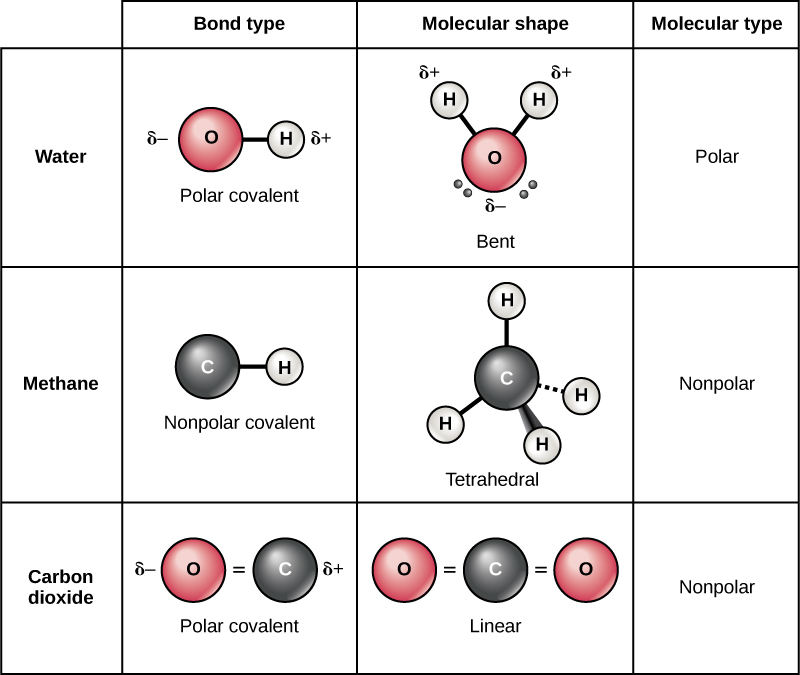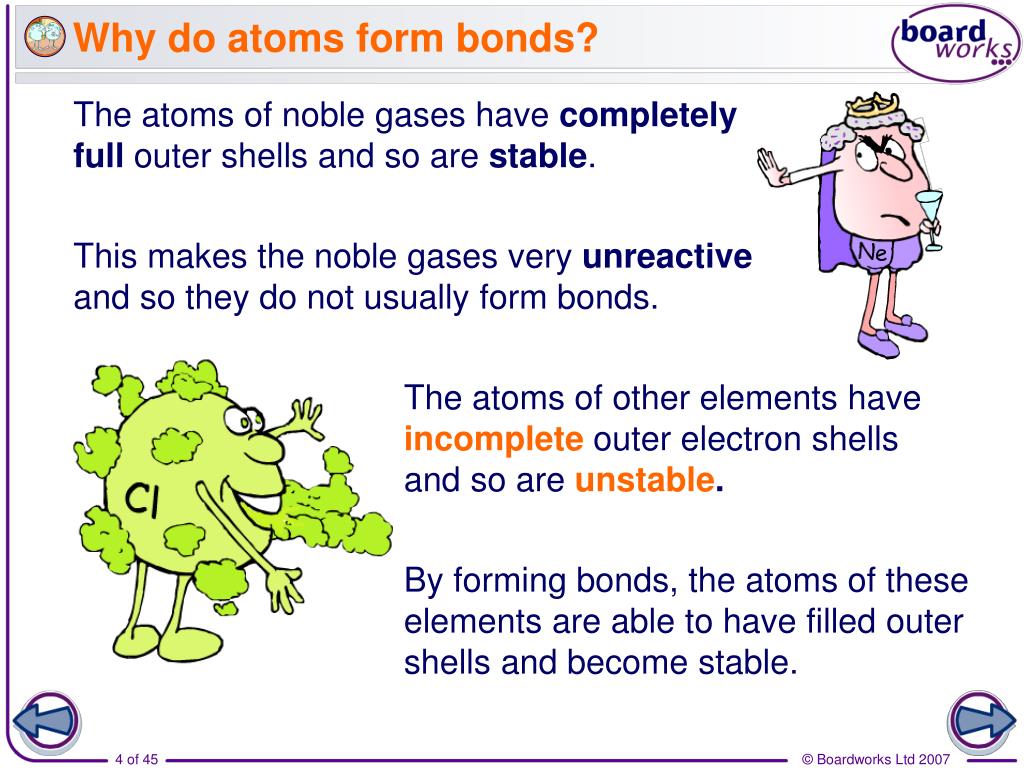In General What Determines Whether Atoms Will Form Chemical Bonds
In General What Determines Whether Atoms Will Form Chemical Bonds - Web the number of electrons in the outermost shell of a particular atom determines its reactivity, or tendency to form chemical bonds with other atoms. The number of protons in the atom's nucleus. To determine whether or not an atom is active. Electrons can be thought of as. The stability of the atom's nucleus. Web it determines how the shared electrons are distributed between the two atoms in a bond. Web key takeaway conceptual problems contributors howard university general chemistry: An atoms first approach unit 1: To determine how many electrons are involved in the chemical bonding of two given. The electron arrangement of electrons in the outermost energy level of the participating atoms.
Consider as an example an atom of sodium,. Web ionic bonding and covalent bonding? This outermost shell is known. Web what determines whether an atom will form a chemical bond with another atom? Web what determines whether atoms will form chemical bonds? Web it determines how the shared electrons are distributed between the two atoms in a bond. The stability of the atom's nucleus. Web the number of electrons in the outermost shell of a particular atom determines its reactivity, or tendency to form chemical bonds with other atoms. The number of protons in the atom's nucleus. When they do so, atoms form ions, or charged particles.
Web in general what determines whether atoms will form chemical bonds see answer advertisement akinny answer: The number of electrons in its outermost. Web key takeaway conceptual problems contributors howard university general chemistry: Web the number of electrons in the outermost shell of a particular atom determines its reactivity, or tendency to form chemical bonds with other atoms. In general, the electron arrangement of the outer energy level oven adam. Web they therefore, would bond together to minimize their potential energy and make them more stable. The electron arrangement of the outer energy level of an atom determines whether or not it will form. Attractive forces between atoms that are strong enough to make the linked elements function as a single unit. Electrons can be thought of as. An atoms first approach unit 1:
Why do atoms form bonds? YouTube
Web in general what determines whether atoms will form chemical bonds? The more strongly an atom attracts the electrons in its bonds, the larger its. Some atoms become more stable by gaining or losing an entire electron (or several electrons). The bohr model of the atom. Electron gain or loss can give an atom a filled outermost.
Atoms, Isotopes, Ions, and Molecules The Building Blocks · Biology
Some of the attractive forces are. An atoms first approach unit 1: The bohr model of the atom. Web key takeaway conceptual problems contributors howard university general chemistry: Web what determines whether atoms will form chemical bonds?
Groundbreaking movie reveals how atoms form chemical compounds
Attractive forces between atoms that are strong enough to make the linked elements function as a single unit. Web they therefore, would bond together to minimize their potential energy and make them more stable. The first way gives rise to what is called an ionic bond. Consider as an example an atom of sodium,. Web in general what determines whether.
Why Do Most Atoms Form Chemical Bonds? Sciencing
When they do so, atoms form ions, or charged particles. Some of the attractive forces are. The number of protons in the atom's nucleus. Web ionic bonding and covalent bonding? Web in general what determines whether atoms will form chemical bonds?
thinkbiggerdesigns Why Do Atoms Ions
The stability of the atom's nucleus. Consider as an example an atom of sodium,. The electron arrangement of the outer energy level of an atom determines whether or not it will form. Web in general what determines whether atoms will form chemical bonds? The number of electrons in its outermost.
PPT Why do atoms form bonds? PowerPoint Presentation, free download
The electron arrangement of the outer energy level of an atom determines whether or not it will form. Web the number of electrons in the outermost shell of a particular atom determines its reactivity, or tendency to form chemical bonds with other atoms. When they do so, atoms form ions, or charged particles. The first way gives rise to what.
CHEMISTRY 9TH CH 4, LECTURE 1, Why do Atoms Form Chemical Bonds
Electron gain or loss can give an atom a filled outermost. To determine whether or not an atom is active. Web in general what determines whether atoms will form chemical bonds see answer advertisement akinny answer: Web in general, what determines whether atoms will form chemical bonds? Web the number of electrons in the outermost shell of a particular atom.
Knowledge Chemical Bonds
In general, the electron arrangement of the outer energy level oven adam. Consider as an example an atom of sodium,. Web they therefore, would bond together to minimize their potential energy and make them more stable. The electron arrangement of the outer energy level of an atom determines whether or not it will form. An atoms first approach unit 1:
Why Do Atoms Form Chemical Bond ,By chemistry with concept. YouTube
Attractive forces between atoms that are strong enough to make the linked elements function as a single unit. Web there are three basic ways that the outer electrons of atoms can form bonds: Consider as an example an atom of sodium,. Web in a mineral, the atoms are held together by chemical bonds, which derive from the electrons. The electron.
A Simple Explanation of Why Atoms Form Chemical Bonds Chemical bond
The first way gives rise to what is called an ionic bond. Web in general what determines whether atoms will form chemical bonds? The bohr model of the atom. Click card to see definition 👆 1. Attractive forces between atoms that are strong enough to make the linked elements function as a single unit.
Web Key Takeaway Conceptual Problems Contributors Howard University General Chemistry:
Click card to see definition 👆 1. The electron arrangement of the outer energy level of an atom determines whether or not it will form. The electron arrangement of electrons in the outermost energy level of the participating atoms. Some of the attractive forces are.
Web What Determines Whether An Atom Will Form A Chemical Bond With Another Atom?
In general, the electron arrangement of the outer energy level oven adam. The stability of the atom's nucleus. Web in general what determines whether atoms will form chemical bonds see answer advertisement akinny answer: Web they therefore, would bond together to minimize their potential energy and make them more stable.
The First Way Gives Rise To What Is Called An Ionic Bond.
This outermost shell is known. Some atoms become more stable by gaining or losing an entire electron (or several electrons). Web it determines how the shared electrons are distributed between the two atoms in a bond. An atoms first approach unit 1:
The Number Of Protons In The Atom's Nucleus.
Web the number and arrangement of electrons of an atom determine the kinds of chemical bonds that it forms and how it reacts with other atoms to form molecules. Covalent, covalent network, ionic, metallic 2. When they do so, atoms form ions, or charged particles. To determine how many electrons are involved in the chemical bonding of two given.









